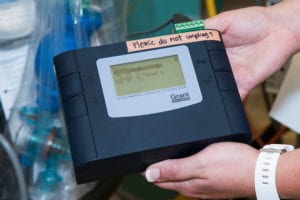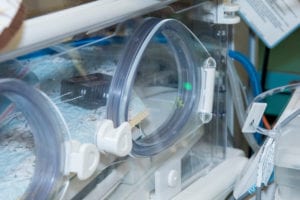Analyzing Temperature Differentials for signs of Neonatal infection
 At the University of South Carolina (UofSC) College of Nursing, a critical research initiative is underway: The PATH Study (Predictive Analysis Using Temperature and Heart Rate). This five-year, National Institutes of Health-funded (NIH/NINR:1R01NR017872) research study involves the skin temperature monitoring of very low birth weight preterm infants during the neonatal period or the first four weeks of the infant’s life. During this time, the risk of infection, such as sepsis and necrotizing enterocolitis (NEC), an intestinal disease with a mortality rate of up to 25%, is greater for premature infants. Thus, the study aims to examine the relationship between abnormal thermal gradients, determined by central and peripheral body temperature, and instances of infection in these low-birth-weight infants.
At the University of South Carolina (UofSC) College of Nursing, a critical research initiative is underway: The PATH Study (Predictive Analysis Using Temperature and Heart Rate). This five-year, National Institutes of Health-funded (NIH/NINR:1R01NR017872) research study involves the skin temperature monitoring of very low birth weight preterm infants during the neonatal period or the first four weeks of the infant’s life. During this time, the risk of infection, such as sepsis and necrotizing enterocolitis (NEC), an intestinal disease with a mortality rate of up to 25%, is greater for premature infants. Thus, the study aims to examine the relationship between abnormal thermal gradients, determined by central and peripheral body temperature, and instances of infection in these low-birth-weight infants.
Kayla Everhart, a Ph.D. student at UofSC, became involved in the PATH study as a research coordinator after choosing neonatal research as her focus and becoming a mentee of the study’s Primary Investigator, Dr. Robin Dail. As the research coordinator, Everhart is directly involved with compiling research data as well as ensuring everything is running smoothly at the NICU sites.
When monitoring the thermal gradients of an infant, two special skin temperature monitoring sensors are placed on the body: one on the abdomen to record core/central temperature and one on the foot to record the peripheral temperature. These temperatures are then compared to determine if the temperature differential indicates infection. Because of the critical need for continuous, accurate, and reliable temperature measurement, data loggers were sought out to record the infant temperatures.
Sourcing A Solution
 Back in 2014, previously used temperature data loggers were discontinued by the manufacturer, causing Dr. Dail to search for a comparable temperature monitoring solution. CAS was able to provide four Grant SQ2010 data loggers that had the ability to connect to the specialized skin temperature thermistor sensors needed for the study. Once Everhart joined the research team, she became involved in the everyday usage and maintenance of the Grant data loggers.
Back in 2014, previously used temperature data loggers were discontinued by the manufacturer, causing Dr. Dail to search for a comparable temperature monitoring solution. CAS was able to provide four Grant SQ2010 data loggers that had the ability to connect to the specialized skin temperature thermistor sensors needed for the study. Once Everhart joined the research team, she became involved in the everyday usage and maintenance of the Grant data loggers.
Once the loggers were received, researchers and NICU site nurses began doing test runs to ensure they were suitable for the study. Everhart quickly identified an issue with wires between the logger and the sensors becoming damaged during heavy use, causing the thermistors to lose the ability to capture accurate temperature readings. Because of the nature of the study, it was critical to ensure steady, reliable temperature measurements.
With some troubleshooting and testing, CAS designed a custom adapter that was able to keep the wires safe and secure while installed on the infant’s bed. The adapter was able to accept the custom RJ-11 connectors from the skin temperature sensors and provide a robust electrical connection to the data logger, while at the same time allowing the nurses to easily attach the sensors.
 Currently, around 17 SQ2010 data loggers with custom adapters are in use at 5 NICU sites. Using the SquirrelView Windows™ software provided with the data loggers, a standard setup file was created to provide an unattended periodic sampling of both sensors. The loggers have the ability to perform the scaling and linearization of the raw sensor measurements so that the recorded data is in the correct format. Configuration of the logger and download of stored data is enabled via a standard USB interface from the PC. The logger features a built-in LCD screen and buttons to allow direct viewing of the data at the bed site plus the ability to easily start and stop the recording manually.
Currently, around 17 SQ2010 data loggers with custom adapters are in use at 5 NICU sites. Using the SquirrelView Windows™ software provided with the data loggers, a standard setup file was created to provide an unattended periodic sampling of both sensors. The loggers have the ability to perform the scaling and linearization of the raw sensor measurements so that the recorded data is in the correct format. Configuration of the logger and download of stored data is enabled via a standard USB interface from the PC. The logger features a built-in LCD screen and buttons to allow direct viewing of the data at the bed site plus the ability to easily start and stop the recording manually.
Benefits & Critiques
According to Everhart, the Grant skin temperature monitoring data loggers are very user-friendly. In particular, the custom adapters provided by CAS are a huge advantage for keeping research running smoothly. The icons on the logger’s screen make it easy to use and troubleshoot and Everhart loves the ability to auto-upload files to excel. On the downside, she wishes it were a bit more compact as it is somewhat bigger than what they had used in the past. Also, the initial setup of the software was a bit challenging, but the staff at CAS were very helpful and knowledgeable with the product and setup.
For more information on Grant data loggers, or to find the ideal solution for your application-specific needs, contact a CAS DataLogger Application Specialist at (800) 956-4437 or request more information.

